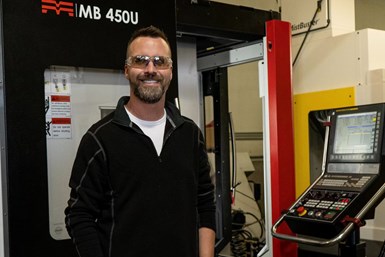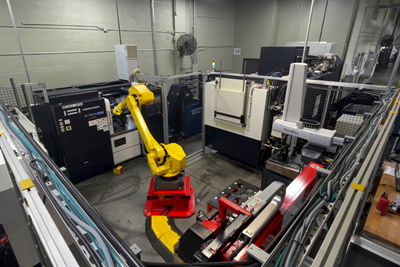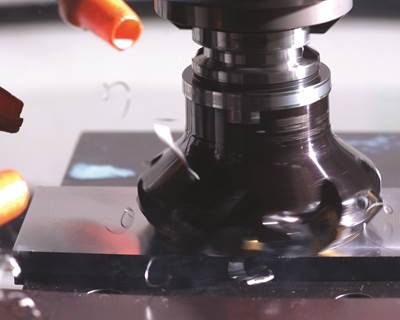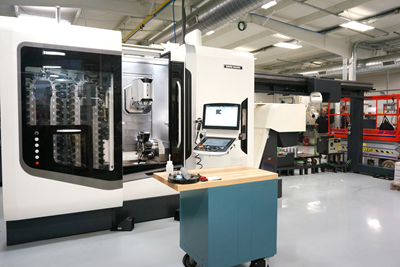Automation Cell Outperforms CNC Machines Fourfold
An automated turnkey machining cell simplified one Utahan manufacturer’s part handling and halved its cycle times.
Share




3rd Gen Machine deviated from traditional turnkey setups of the JobShop Cell by requesting the chance to adapt its existing programs to the automation cell, rather than rely on Methods Machine Tool to program 3rd Gen’s parts. The shop also asked for the capability to swap between part programs with a single value input on the teach pendant.
Evan Jones founded 3rd Gen Machine in 2007, with one customer, a handful of employees and a few hand-me-down machines from his father’s mom-and-pop shop. Fifteen years later, his shop is nearly bursting out the doors of its Logan, Utah, location. While open to all sorts of work, 3rd Gen Machine has found a niche using its horizontal machining centers to manufacture 6061 and 7075 aluminum parts for the firearm and outdoor recreation equipment industries.
Recently, however, 3rd Gen Machine’s tried-and-true process started proving not-so-true. Chip imprint scratches created too much scrap and manual machine loading swallowed too much time. These problems came to a head with a spindle crash.
“That day, we sent a purchase order to Methods for the automation system,” Jones says.
Time for Turnkey
Jones is referring to Methods Machine Tools’ JobShop Cell, which includes two FANUC RoboDrills and an articulating FANUC LR Mate 200iD robot. The RoboDrills are short-bed, vertical machines, and the whole cell occupies only slightly more floor space than one of Jones’ existing HMCs. For 3rd Gen Machine’s first JobShop Cell, Jones asked Methods to program a function into the robot’s teach pendant that would enable switching between part programs with a single value adjustment — an especially valuable capability for a client order with nine different part types that arrived just before 3rd Gen bought the automation cell.
The JobShop Cell ended up being four times as productive as any of 3rd Gen Machine’s other machining centers.
Originally, Methods estimated a cycle time of 1 to 2 minutes for a simple part, with another 15 to 20 seconds for part changes. Jones had been impressed with this estimation, which would have been down from an average of two minutes for the same part using the shop’s HMCs. He was still unsure about the viability of setting up only two parts at a time (one per spindle) rather than the full pallets of 3rd Gen Machine’s HMCs, but the downtime reductions stemming from the robot-automated part loading made up for it. Further part program optimizations lowered machining time to between 45 seconds and 1.5 minutes, and the JobShop Cell ended up being four times as productive as any of 3rd Gen Machine’s other machining centers.
The JobShop Cell also enabled lights-out machining — or, as close to it as an already 24-hour operation can get. 3rd Gen Machine’s machinists run multiple machines simultaneously, so the automation cell’s ability to run unattended for hours at a time eases the strain on the machinists even as it improves the shop’s productivity. Jones quickly bought a second JobShop Cell to take advantage of this productivity.

3rd Gen Machine owner Evan Jones compares learning new technology to a “man versus machine” battle that requires adapting to evolving circumstances. In this case, the JobShop Cells were so productive that spacial bottlenecks required staging other machines’ finished parts in shipping containers.
Chip Maintenance
Adopting the JobShop Cells wasn’t completely free of adjustments, however. Jones found that chips coming off the parts in the RoboDrills could land on the robot’s sensors, making the robot think it was engaged with a part instead of performing offline prep work.
3rd Gen Machine engineered some components as a stopgap to clean off the sensors until Methods could install additional air ports on the robot.
Programming the Future
Methods may have performed the initial set up for the FANUC LR Mate 200iD in 3rd Gen Machine’s JobShop Cell, but the shop is not content to rest there. 3rd Gen Machine programs its parts into the JobShop Cells, and actively works to improve them — as demonstrated by the 25% optimization in cycle times for simple parts mentioned earlier. Moreover, Jones and a few of his machinists are taking robotics programming courses to fine-tune the robot and prove the Cell as they see fit.
The extra productivity of these machines has made 3rd Gen Machine a tidy profit, and Jones is using that capacity to expand with a new building. Until the building is finished, however, 3rd Gen’s largest problem might be that the JobShop Cell is too productive — the company has needed to purchase shipping containers so it has the space to stage finished goods from its other machines.
Related Content
3 Ways Artificial Intelligence Will Revolutionize Machine Shops
AI will become a tool to increase productivity in the same way that robotics has.
Read MoreStuder's Automation, Entry-Level Solutions Take Center Stage
At its 2024 Music Motion Meeting, Studer AG showed off its entry-level line of grinding machines, as well as its newest universal loading system.
Read MoreAutomation is for Everyone
Not just for large shops, automation can help even the smallest shops solve labor challenges and become more profitable and efficient.
Read MoreSetting Up the Building Blocks for a Digital Factory
Woodward Inc. spent over a year developing an API to connect machines to its digital factory. Caron Engineering’s MiConnect has cut most of this process while also granting the shop greater access to machine information.
Read MoreRead Next
Robotic Cell Improves Quote, Wins Shop an Aerospace Job
By adding a FANUC-controlled automation cell, Kemco Aerospace Manufacturing improved the cost-competitiveness of its quote and won a major aerospace job.
Read MoreRobotic Cell Locks In Time, Cost Savings
Having implemented robotic systems in the sheet metal side of its business, this Nevada-based shop wanted to obtain similar automation systems for its CNC machining operations. The Fanuc JobShop Cell from Methods Machine Tools has reduced both costs and cycle times on one of the shop’s most important jobs.
Read MoreModern Machine Shops Must Invest in Technology and Training
Investing in new technology, training and automation is a necessity for keeping up with the changing nature of manufacturing, according to Tony Staub, founder of Staub Precision Machine Inc.
Read More




























